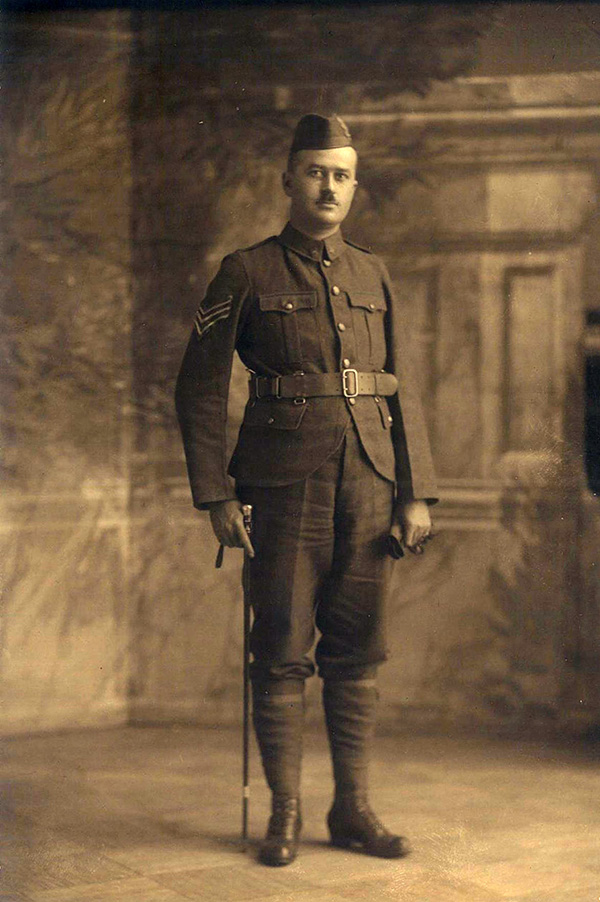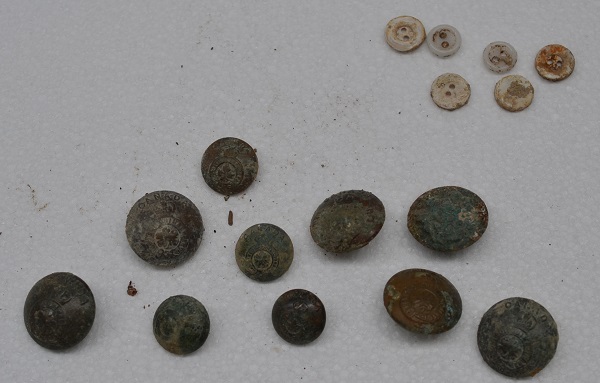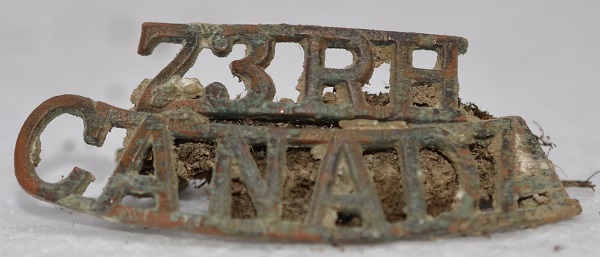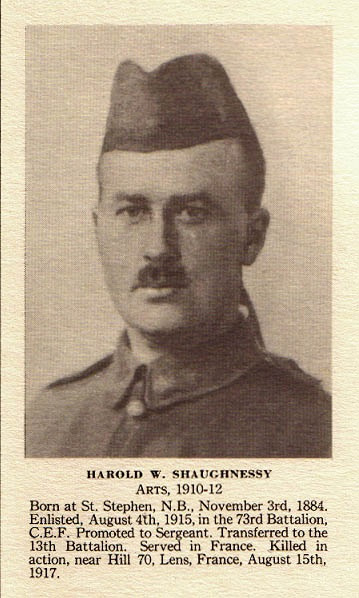Sergeant Harold Wilfred Shaughnessy
In 2016, remains were found in Vendin-le-Vieil, France. The remains were confirmed as those of Sergeant Harold Wilfred Shaughnessy.
- Born 3 November 1884 in St. Stephen, New Brunswick
- Died 16 August 1917 at the age of 32
- Died a member of the 13th Canadian Infantry Battalion (Royal Highlanders of Canada), CEF
- Remains discovered on 6 June 2016 in Vendin-le-Vieil, France
- Buried at Commonwealth War Graves Commission’s Loos British Cemetery, Section 2, Plot A, Grave 13
Harold Wilfred Shaughnessy was born 3 November 1884, in St. Stephen, New Brunswick to Mary Margaret Shaughnessy and John Shaughnessy. He was a stenographer before enlisting in the Canadian Expeditionary Force (CEF) in Montreal on 4 August 1915.
He enlisted with the 73rd Canadian Infantry Battalion (Royal Highlanders of Canada), CEF, making him one of the original members of the battalion.
On 8 September 1915, Shaughnessy received a promotion to Sergeant, and following training in eastern Canada departed Halifax with the 73rd Battalion on 31 March 1916, arriving at Bramshott in England 10 April 1916.
After more training in England, the 73rd Battalion arrived in France, at Le Havre, on 2 August 1916. Sergeant Shaughnessy participated in the closing battles of the Somme and the preparations for the attack on Vimy. The 73rd Battalion participated in the attack on Vimy Ridge attacking on the far left of the Canadian Corps front near Hill 145.
Because the 73rd Battalion was disbanded, Sergeant Shaughnessy transferred to the 13th Canadian Infantry Battalion (Royal Highlanders of Canada), 3rd Brigade, 1st Division CEF on 8 May 1917. The 13th Battalion took Sergeant Shaughnessy on strength 9 May 1917 but the battalion attached him to Canadian Corps Headquarters for three months.
On 11 August 1917, Sergeant Shaughnessy returned to the 13th Battalion four days before the assault on Hill 70. The 13th Battalion fought in the assault on Hill 70 between 15 and 25 August 1917. The attack was in two stages with the capture of two objective lines. The 13th Battalion secured its part of the first objective called the “Blue Line” soon after the start of the attack. The second objective, called the “Green Line” was secured later that same day. Sergeant Shaughnessy most likely lost his life in taking the Blue Line because his remains were discovered near the location of this objective.
Following the war, Sergeant Shaughnessy’s name was engraved on the Canadian National Vimy Memorial commemorating Canadian soldiers who died during the First World War and have no known grave. He was also commemorated on a memorial in his hometown of St. Stephen, New Brunswick.
During an ordnance clearing process in June 2016, his remains were discovered near where the Blue Line had been.
Through historical, anthropological and archaeological analysis, with the assistance of the Canadian Forces Forensic Odontology Response Team, and the Canadian Museum of History, the Casualty Identification Review Board was able to confirm the identity of the remains as Sergeant Harold Wilfred Shaughnessy in December 2016.
Sergeant Shaughnessy was buried on August 24, 2017 in Commonwealth War Graves Commission’s Loos British Cemetery in Loos-en-Gohelle, France by members of The Black Watch (Royal Highland Regiment) of Canada, from Montreal, Quebec. Attending the burial was Sergeant Shaughnessy’s great-nephew and his wife, as well as representatives of the Government of Canada, the local French government and the Canadian Armed Forces. Photographs of the ceremony can be viewed on the Canadian Army’s flickr page. The album is called First World War Internments and photographs of Sergeant Shaughnessy’s burial are identified as “Hill 70 internment”.
For further information on Sergeant Shaughnessy, you can view his personnel file on the Library and Archives Canada website.
Information about casualty identification
Page details
- Date modified:








